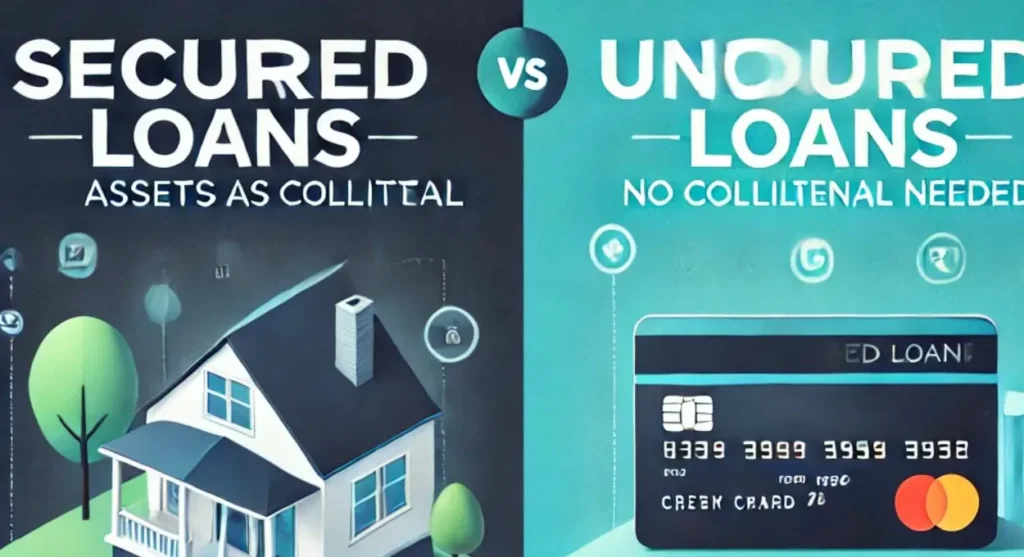Loans are a cornerstone of personal and business finance, helping individuals achieve goals like buying a home, starting a business, or managing unforeseen expenses. However, not all loans are created equal. A crucial distinction lies between secured and unsecured loans. Understanding this difference can help borrowers make informed decisions based on their financial needs and risk tolerance.
This article delves deep into the key differences between secured and unsecured loans, including their definitions, benefits, risks, and practical applications.
Secured Loans: Borrowing Backed by Collateral
A secured loan requires the borrower to pledge an asset as collateral to guarantee repayment. Collateral can be a tangible or intangible asset, such as real estate, vehicles, or investment accounts. The lender holds the right to seize the collateral if the borrower fails to meet the repayment terms.
Examples of Secured Loans
- Mortgage Loans: The property being purchased serves as collateral.
- Auto Loans: The vehicle bought with the loan acts as security.
- Home Equity Loans: Borrowers use the equity in their home as collateral. Home loans, a common type of secured loan, can still be obtained with bad credit. Explore tips in How to Get a Home Loan with Bad Credit: A Guide.
- Secured Personal Loans: Assets like savings accounts or valuable items are pledged.
For entrepreneurs, understanding loan types is crucial. Learn how to secure the right funding for your business in our guide on Small Business Loan: How to Secure Funding Easily.
Features of Secured Loans
- Lower Interest Rates: Due to the reduced risk for lenders, secured loans generally have lower interest rates than unsecured loans.
- Higher Loan Amounts: Borrowers can typically access larger amounts because the collateral provides security for the lender.
- Extended Loan Terms: Secured loans often come with longer repayment periods, allowing for smaller monthly payments.
- Credit Score Impact: While good credit can help, some lenders approve secured loans even for those with poor credit, provided sufficient collateral is available.
Unsecured Loans: No Collateral Required
An unsecured loan, on the other hand, does not require any collateral. Approval is based on the borrower’s creditworthiness, including factors like credit score, income, and financial history. Because no assets back the loan, the risk for lenders is higher, which often leads to stricter eligibility criteria.
Examples of Unsecured Loans
- Personal Loans: Used for various purposes, such as home improvement or medical expenses.
- Credit Cards: The balance borrowed on a credit card is unsecured.
- Student Loans: Most education loans are unsecured and rely on creditworthiness or co-signers.
- Unsecured Lines of Credit: Funds are borrowed without collateral for flexible use.
Features of Unsecured Loans
- Higher Interest Rates: Without collateral, lenders compensate for the increased risk by charging higher interest.
- Lower Loan Amounts: Borrowers may not access as much funding as they would with secured loans.
- Flexible Use: Funds can be used for a wide range of purposes without restrictions.
- Risk for Borrowers: While assets aren’t at risk, defaulting on an unsecured loan can severely damage credit scores and lead to legal action.
If you’re considering an unsecured personal loan, explore our guide on Smart Loan Strategies for Every Life Stage for detailed comparisons and tips.
Key Differences Between Secured and Unsecured Loans
The fundamental differences between secured and unsecured loans lie in the role of collateral, interest rates, risk levels, and loan terms.
| Aspect | Secured Loans | Unsecured Loans |
|---|---|---|
| Collateral | Requires collateral (e.g., property, vehicle) | No collateral required |
| Risk to Borrower | Asset seizure if loan defaults | No immediate asset loss |
| Risk to Lender | Lower risk due to collateral | Higher risk due to lack of collateral |
| Interest Rates | Generally lower | Higher due to increased lender risk |
| Loan Amounts | Larger amounts available | Smaller amounts compared to secured loans |
| Loan Terms | Longer repayment periods | Shorter repayment periods |
| Eligibility | Easier for borrowers with poor credit | Strict credit requirements |

Benefits of Secured Loans
Secured loans are an excellent option for borrowers who:
- Need larger loan amounts: The collateral reduces the lender’s risk, making them willing to lend more.
- Prefer lower interest rates: The security of collateral often leads to better interest terms.
- Have lower credit scores: Collateral can offset a less-than-stellar credit history.
- Plan for long-term repayment: Longer terms allow for manageable monthly payments.
Risks of Secured Loans
- Loss of Asset: If you default, the lender can seize the collateral.
- Complex Application Process: Valuing and verifying collateral can take time and effort.
- Risk of Over-Borrowing: The accessibility of larger amounts can lead to borrowing more than necessary.
Benefits of Unsecured Loans
Unsecured loans suit borrowers who:
- Don’t own valuable assets: No need to pledge property or savings.
- Need quick access to funds: Approval processes are often faster.
- Have excellent credit: A strong credit profile ensures better terms.
- Want flexibility: Funds can be used for virtually any purpose.
Risks of Unsecured Loans
- High Interest Rates: The lack of collateral makes loans more expensive.
- Strict Eligibility Criteria: Borrowers with poor credit may struggle to qualify.
- Lower Loan Limits: Access to large amounts may be restricted.
When to Choose a Secured Loan
A secured loan may be your best option if:
- You need to borrow a substantial sum, such as for a house or car.
- You’re confident in your ability to repay the loan and avoid risking your assets.
- You want to rebuild your credit by leveraging collateral.
Example Scenario
A homeowner planning a major renovation might opt for a home equity loan to fund the project, using their property as collateral.
When to Choose an Unsecured Loan
Unsecured loans are ideal if:
- You need quick, flexible funding for personal expenses.
- You have a high credit score and qualify for competitive rates;
- and You don’t own significant assets or prefer not to risk losing them.
Example Scenario
A student needing funds to cover tuition may apply for an unsecured student loan, relying on their creditworthiness or a co-signer.
Impact on Credit Scores
Both loan types affect your credit score in similar ways:
- On-time Payments: Boost your score regardless of loan type.
- Missed Payments: Damage your score and may lead to legal consequences.
- Debt-to-Income Ratio: Higher balances can affect your ability to secure future loans.
Secured loans, however, might be more forgiving in negotiations, as lenders can rely on collateral rather than pursuing collections.
Choosing the Right Loan for Your Needs
Selecting between secured and unsecured loans depends on:
- Your Financial Situation: Assess your income, credit score, and asset availability.
- Loan Purpose: Large purchases or investments favour secured loans, while unsecured loans are better for smaller, flexible needs.
- Risk Tolerance: Consider whether you’re comfortable pledging assets as collateral.
Conclusion
Understanding the difference between secured and unsecured loans is essential for navigating financial decisions. Secured loans offer lower interest rates and higher amounts but come with the risk of losing pledged assets. Unsecured loans provide flexibility and less risk to assets but at a higher cost and with stricter approval criteria.
Before taking a loan, evaluate your financial goals, repayment ability, and risk tolerance. The right choice can set you on a path to financial stability and success.
